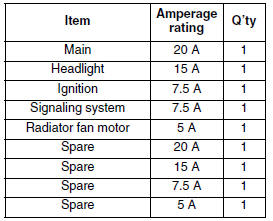Yamaha YZF-R125 Service Manual: Checking the fuses
The following procedure applies to all of the fuses.
| CAUTION: To avoid a short circuit, always turn the main switch to "OFF" when checking or replacing a fuse. |
1. Remove:
- Rider seat Refer to "GENERAL CHASSIS" on page 4-1.
2. Check:
- Fuse
a. Connect the pocket tester to the fuse and check the continuity.
Set the pocket tester selector to "
 × 1".
× 1".
b. If the pocket tester indicates " ", replace the fuse.
3. Replace:
- Blown fuse
a. Set the main switch to "OFF".
b. Install a new fuse of the correct amperage rating.
c. Set on the switches to verify if the electrical circuit is operational.
d. If the fuse immediately blows again, check
the electrical circuit
| WARNING Never use a fuse with an amperage rating other than that specified. Improvising or using a fuse with the wrong amperage rating may cause extensive damage to the electrical system, cause the lighting and ignition systems to malfunction and could possibly cause a fire. |
4. Install:
- Rider seat Refer to "GENERAL CHASSIS" on page 4-1.
 Checking the condition of the bulb sockets
Checking the condition of the bulb sockets
The following procedure applies to all of the bulb
sockets.
1. Check:
Bulb socket (for continuity)
(with the pocket tester)
No continuity Replace.
NOTE:
Check each bulb socket for continui ...
 Checking and charging the battery
Checking and charging the battery
WARNINGBatteries generate explosive hydrogen gas
and contain electrolyte which is made of poisonous
and highly caustic sulfuric acid.
Therefore, always follow these preventive
mea ...
Other materials:
Checking the water pump
1. Check:
Water pump housing cover
Water pump housing
Cracks/damage Replace.
Impeller shaft
Cracks/damage/wear Replace.
Bearing
Rough movement Replace.
Radiator outlet hose
Cracks/damage Replace.
...
Introduction
WARNINGDisc brake components rarely require
disassembly.
Therefore, always follow these preventive
measures:
Never disassemble brake components unless
absolutely necessary.
If any connection on the hydraulic brake
system is disconnected, the entire brake
sy ...
